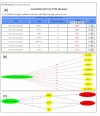TCMGeneDIT: a database for associated traditional Chinese medicine, gene and disease information using text mining
- PMID: 18854039
- PMCID: PMC2584015
- DOI: 10.1186/1472-6882-8-58
TCMGeneDIT: a database for associated traditional Chinese medicine, gene and disease information using text mining
Abstract
Background: Traditional Chinese Medicine (TCM), a complementary and alternative medical system in Western countries, has been used to treat various diseases over thousands of years in East Asian countries. In recent years, many herbal medicines were found to exhibit a variety of effects through regulating a wide range of gene expressions or protein activities. As available TCM data continue to accumulate rapidly, an urgent need for exploring these resources systematically is imperative, so as to effectively utilize the large volume of literature.
Methods: TCM, gene, disease, biological pathway and protein-protein interaction information were collected from public databases. For association discovery, the TCM names, gene names, disease names, TCM ingredients and effects were used to annotate the literature corpus obtained from PubMed. The concept to mine entity associations was based on hypothesis testing and collocation analysis. The annotated corpus was processed with natural language processing tools and rule-based approaches were applied to the sentences for extracting the relations between TCM effectors and effects.
Results: We developed a database, TCMGeneDIT, to provide association information about TCMs, genes, diseases, TCM effects and TCM ingredients mined from vast amount of biomedical literature. Integrated protein-protein interaction and biological pathways information are also available for exploring the regulations of genes associated with TCM curative effects. In addition, the transitive relationships among genes, TCMs and diseases could be inferred through the shared intermediates. Furthermore, TCMGeneDIT is useful in understanding the possible therapeutic mechanisms of TCMs via gene regulations and deducing synergistic or antagonistic contributions of the prescription components to the overall therapeutic effects. The database is now available at http://tcm.lifescience.ntu.edu.tw/.
Conclusion: TCMGeneDIT is a unique database that offers diverse association information on TCMs. This database integrates TCMs with biomedical studies that would facilitate clinical research and elucidate the possible therapeutic mechanisms of TCMs and gene regulations.
Figures



Similar articles
-
Integrative mining of traditional Chinese medicine literature and MEDLINE for functional gene networks.Artif Intell Med. 2007 Oct;41(2):87-104. doi: 10.1016/j.artmed.2007.07.007. Epub 2007 Sep 5. Artif Intell Med. 2007. PMID: 17804209
-
Recognizing names in biomedical texts: a machine learning approach.Bioinformatics. 2004 May 1;20(7):1178-90. doi: 10.1093/bioinformatics/bth060. Epub 2004 Feb 10. Bioinformatics. 2004. PMID: 14871877
-
Development of traditional Chinese medicine clinical data warehouse for medical knowledge discovery and decision support.Artif Intell Med. 2010 Feb-Mar;48(2-3):139-52. doi: 10.1016/j.artmed.2009.07.012. Epub 2010 Feb 1. Artif Intell Med. 2010. PMID: 20122820
-
Knowledge discovery in traditional Chinese medicine: state of the art and perspectives.Artif Intell Med. 2006 Nov;38(3):219-36. doi: 10.1016/j.artmed.2006.07.005. Epub 2006 Aug 22. Artif Intell Med. 2006. PMID: 16930966 Review.
-
Towards Semantic e-Science for Traditional Chinese Medicine.BMC Bioinformatics. 2007 May 9;8 Suppl 3(Suppl 3):S6. doi: 10.1186/1471-2105-8-S3-S6. BMC Bioinformatics. 2007. PMID: 17493289 Free PMC article. Review.
Cited by
-
TCMID: Traditional Chinese Medicine integrative database for herb molecular mechanism analysis.Nucleic Acids Res. 2013 Jan;41(Database issue):D1089-95. doi: 10.1093/nar/gks1100. Epub 2012 Nov 29. Nucleic Acids Res. 2013. PMID: 23203875 Free PMC article.
-
A corpus of plant-disease relations in the biomedical domain.PLoS One. 2019 Aug 28;14(8):e0221582. doi: 10.1371/journal.pone.0221582. eCollection 2019. PLoS One. 2019. PMID: 31461491 Free PMC article.
-
Computational approaches to predict the toxicity of bioactive natural products: a mini review of methodologies.Food Sci Biotechnol. 2024 Sep 9;34(2):299-305. doi: 10.1007/s10068-024-01701-1. eCollection 2025 Jan. Food Sci Biotechnol. 2024. PMID: 39944664 Review.
-
To Unveil the Molecular Mechanisms of Qi and Blood through Systems Biology-Based Investigation into Si-Jun-Zi-Tang and Si-Wu-Tang formulae.Sci Rep. 2016 Sep 28;6:34328. doi: 10.1038/srep34328. Sci Rep. 2016. PMID: 27677604 Free PMC article.
-
Network pharmacology: an efficient but underutilized approach in oral, head and neck cancer therapy-a review.Front Pharmacol. 2024 Jul 5;15:1410942. doi: 10.3389/fphar.2024.1410942. eCollection 2024. Front Pharmacol. 2024. PMID: 39035991 Free PMC article. Review.
References
-
- Chan K. Progress in traditional Chinese medicine. Trends Pharmacol Sci. 1995;16:182–187. - PubMed
-
- Cheng JT. Review: drug therapy in Chinese traditional medicine. J Clin Pharmacol. 2000;40:445–450. - PubMed
-
- Hseu YC, Wu FY, Wu JJ, Chen JY, Chang WH, Lu FJ, Lai YC, Yang HL. Anti-inflammatory potential of Antrodia Camphorata through inhibition of iNOS, COX-2 and cytokines via the NF-kappaB pathway. Int Immunopharmacol. 2005;5:1914–1925. - PubMed
Publication types
MeSH terms
LinkOut - more resources
Full Text Sources
Research Materials

